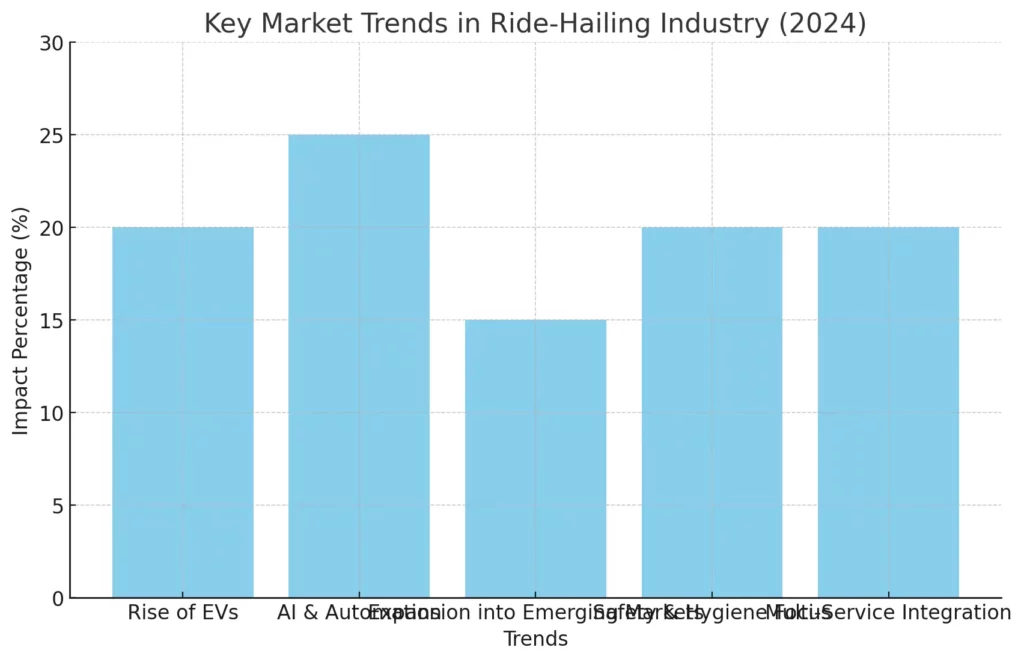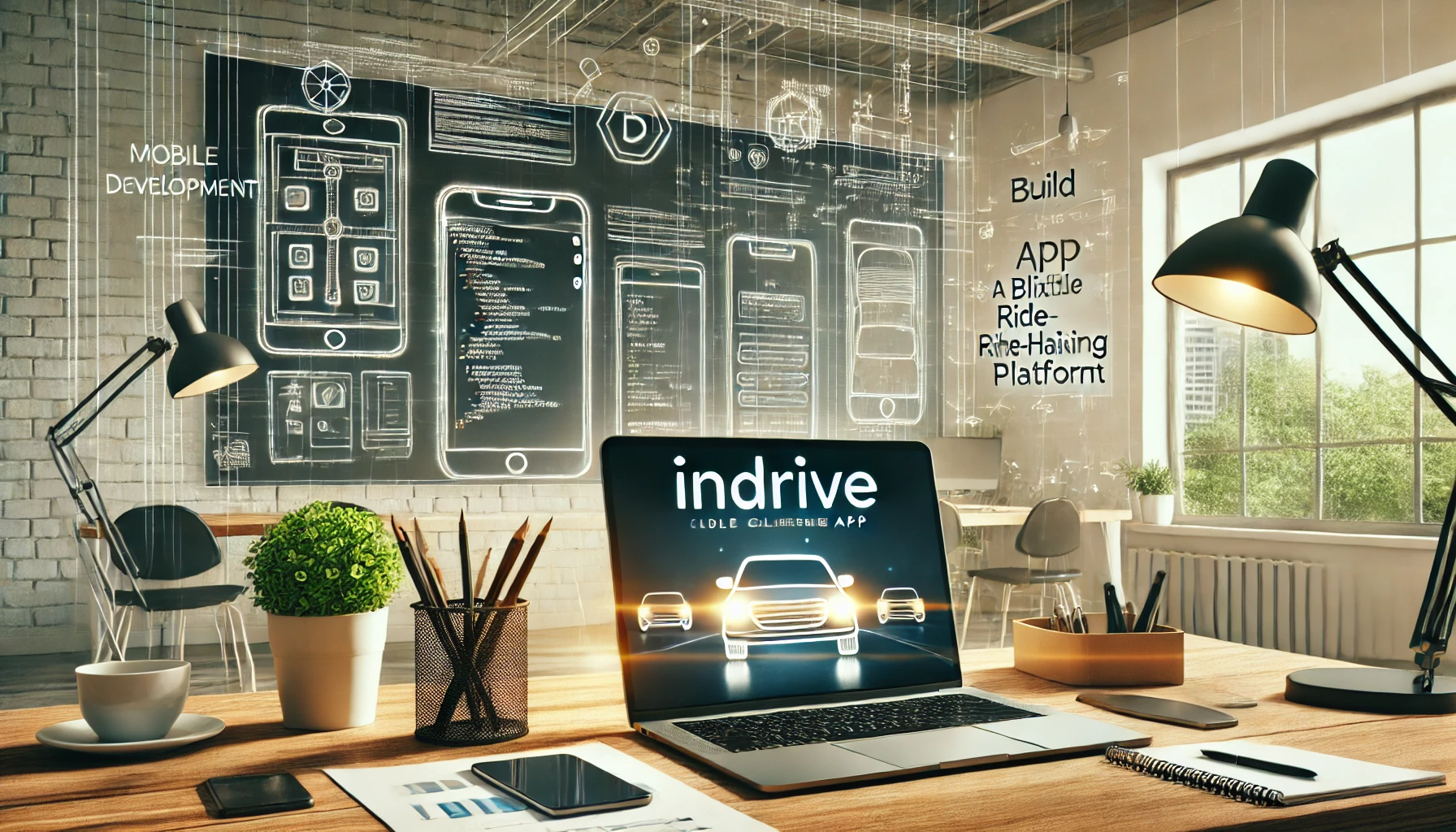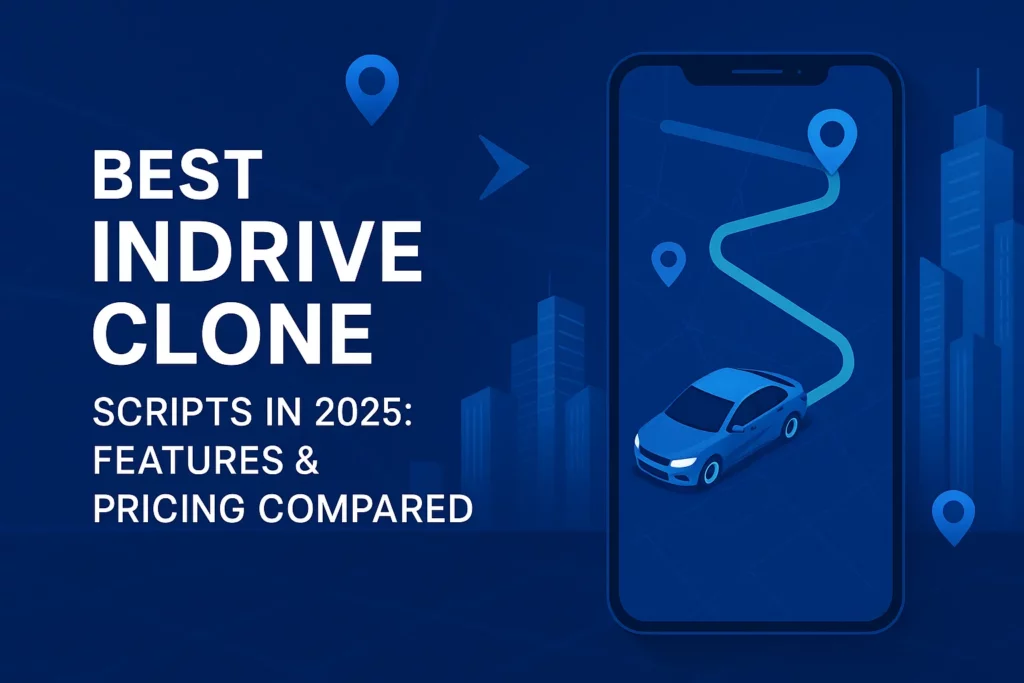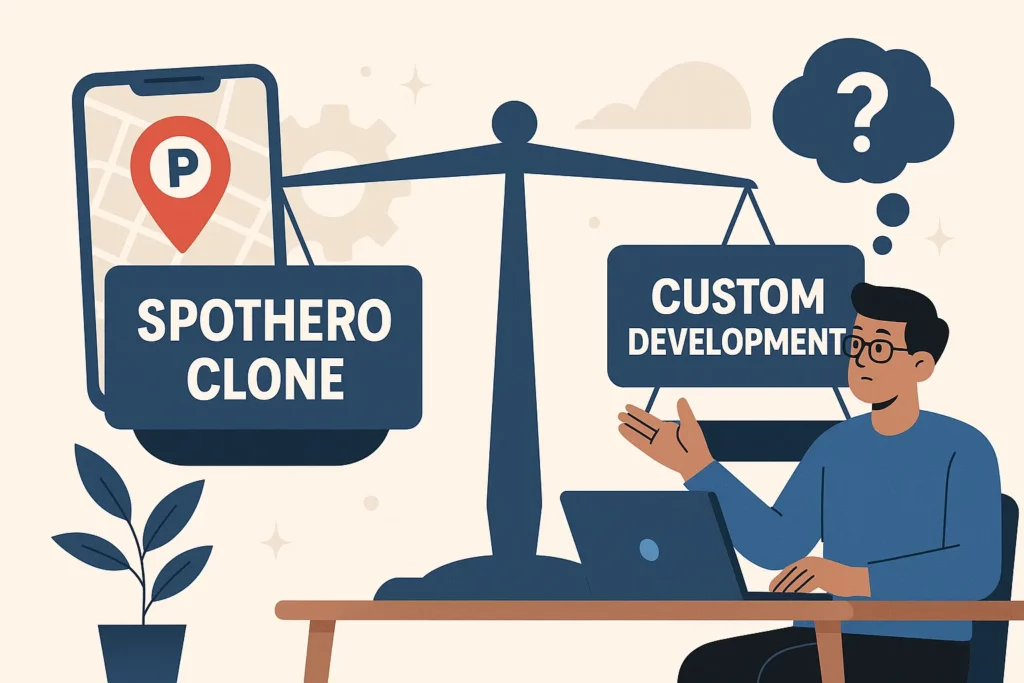In today’s fast-evolving transportation industry, ride-hailing apps have become a necessity rather than a luxury. If you’re looking to develop a ride-hailing app similar to Indrive, this guide will provide a step-by-step approach to building a flexible ride-hailing platform that can scale globally. With the increasing demand for on-demand ride-hailing apps, launching an Indrive clone app can be a lucrative business opportunity.
The ride-hailing market is evolving rapidly, and there is a growing need for flexible and customizable solutions to cater to diverse audiences worldwide. Building a ride-hailing app like Indrive can help you tap into this lucrative industry by offering unique features such as fare negotiation and seamless user experiences. This blog will guide you through everything you need to know about building an Indrive clone app, from market trends to the development process and key features, empowering you to create a platform that scales globally.
Why Build an Indrive Clone App?
Creating an Indrive clone app offers several advantages:
- Customizability: You have the freedom to tailor the app features according to specific markets and user preferences.
- Scalability: With a well-structured development approach, the app can easily expand into new regions or countries.
- Cost-Effective: Leveraging a Indrive clone script reduces the development time and costs significantly compared to building an app from scratch.
Market Overview: The Demand for On-Demand Ride-Hailing Apps
The global ride-hailing market is projected to grow rapidly over the next few years, with increasing demand for on-demand ride-hailing apps. Key players like Indrive have demonstrated the success and potential of this business model. As cities expand and populations grow, the need for flexible and efficient transportation solutions becomes critical.
Market Trends for Ride-Hailing Apps
The global ride-hailing market is experiencing rapid growth and transformation. With urbanization on the rise and the increasing need for efficient transportation solutions, ride-hailing apps have become integral to modern commuting. In 2024, the industry is expected to grow even further, propelled by innovations in technology such as AI-driven route optimization, electric vehicles (EVs), and expansion into untapped markets.
Key Market Trends:
- Rise of Electric Vehicles (EVs): Companies are increasingly integrating EVs into their fleets, reducing carbon emissions and operational costs.
- AI and Automation: AI-driven route optimization and autonomous vehicle integration are becoming major trends in enhancing service efficiency.
- Expansion into Emerging Markets: Companies are focusing on expanding their services in developing countries, tapping into regions with rising urbanization.
- Focus on Safety and Hygiene: Post-pandemic, user demand for safety features like hygiene ratings, driver health monitoring, and sanitized vehicles is on the rise.
- Multi-Service Integration: Super apps combining ride-hailing with other services like food delivery, package delivery, and concierge services are becoming increasingly popular.

Essential Features for Your Indrive Clone App
To build a successful custom ride-hailing platform, incorporating the following features is crucial:
- User Registration and Profile Management
- Easy sign-up and profile management options for both drivers and passengers.
- Integration with social media and email for quick login.
- Real-Time GPS Tracking
- Accurate, real-time tracking for users to monitor driver locations and trip progress.
- Integration with popular GPS APIs for reliable navigation.
- Ride Matching and Cost Estimation
- An intelligent ride-matching system that pairs users with nearby drivers.
- Transparent fare calculation based on distance, time, and other variables.
- Multiple Payment Options
- Integration of various payment gateways to accept credit cards, digital wallets, and cash.
- Ensuring secure and smooth transactions within the app.
- Ratings and Feedback System
- Allowing users and drivers to rate each other, ensuring quality service and accountability.
- Mechanisms to address complaints or feedback promptly.
- Admin Dashboard
- A powerful admin panel for monitoring app performance, managing users, and adjusting app settings.
- Real-time analytics to track app growth and user behavior.
Development Process for Building Your Indrive Clone App
To create a custom ride-hailing platform like Indrive, a structured development approach is essential:
- Market Research and Competitor Analysis
- Start by analyzing the target market and competitors. Understand what features are essential and how competitors are structuring their platforms.
- Determine the pain points of users in existing apps and find ways to address them with unique features.
- Choosing the Right Tech Stack
- Use a tech stack that supports scalability and flexibility. Recommended options include:
- Frontend: React Native or Flutter for cross-platform compatibility.
- Backend: Node.js, PHP Laravel, or Python for a robust and scalable server.
- Database: MySQL or MongoDB for data management.
- Leverage a Indrive clone script as a starting point to save time and development costs.
- Use a tech stack that supports scalability and flexibility. Recommended options include:
- App Design and Development
- Design a user-friendly interface focusing on simplicity and ease of use.
- Develop the MVP (Minimum Viable Product) to test the core functionalities before full-scale development.
- Testing and Quality Assurance
- Conduct rigorous testing to ensure the app runs smoothly across different devices and networks.
- Use real-world scenarios to simulate different conditions and user behaviors.
- Launch and Post-Launch Support
- Deploy the app on app stores and continuously monitor user feedback.
- Offer post-launch support to fix bugs, roll out updates, and introduce new features based on user demand.
Cost of Development for an Indrive Clone App
The cost of developing an Indrive clone app varies depending on features, technology stack, development time, and team expertise. Below is a table showing estimated costs based on different stages of development:
| Development Stage | Cost Estimate (USD) |
|---|---|
| Market Research & Planning | $5,000 – $10,000 |
| UI/UX Design | $8,000 – $15,000 |
| Frontend Development | $15,000 – $25,000 |
| Backend Development | $20,000 – $35,000 |
| Testing & Quality Assurance | $5,000 – $10,000 |
| Deployment & Post-Launch Support | $5,000 – $8,000 |
| Total Estimated Cost | $58,000 – $103,000 |
This estimate varies based on factors like location, team size, and complexity of features.
Cost Calculator for Indriver Clone App
Indrive Clone App Cost Calculator
Competitor Analysis for Ride-Hailing Apps
Analyzing competitors in the ride-hailing industry is essential for building a successful Indrive clone app. By understanding what key players are offering, their strengths, and their weaknesses, you can identify opportunities and differentiate your platform. Here’s a breakdown of some major competitors in the ride-hailing market:
- Uber
- Strengths: Global brand recognition, diverse service offerings (e.g., Uber Eats, Uber Pool), advanced technology (AI-driven route optimization).
- Weaknesses: High operational costs, ongoing regulatory challenges, and criticism over driver compensation.
- Lyft
- Strengths: Strong presence in North America, focus on customer service and loyalty programs, environmentally friendly options (Lyft Green).
- Weaknesses: Limited global reach compared to competitors, dependence on the U.S. market makes it vulnerable to local economic changes.
- Indrive
- Strengths: Unique fare negotiation model, strong foothold in developing markets, and low operational costs due to its driver-centric approach.
- Weaknesses: Lack of advanced features like ride-sharing or diverse service options, limited presence in high-revenue markets (e.g., Europe, North America).
- Bolt (Taxify)
- Strengths: Rapid expansion across Europe and Africa, low commission rates for drivers, and diverse services (e.g., scooters, car rentals).
- Weaknesses: Competition from established players, challenges in maintaining quality service while scaling rapidly.
- Grab
- Strengths: Dominant player in Southeast Asia with a super app model (ride-hailing, food delivery, financial services), excellent local partnerships.
- Weaknesses: Heavy reliance on the Southeast Asian market, intense competition from local startups and global players like Uber.
Competitor Analysis Table
| Competitor | Strengths | Weaknesses | Opportunities | Threats |
|---|---|---|---|---|
| Uber | Global reach, AI-driven tech, diverse services | High operational costs, regulatory issues | Expansion into new markets, autonomous vehicles | Local competitors, driver retention issues |
| Lyft | Strong customer service, loyalty programs, eco-friendly options | Limited global presence, U.S. market dependence | Diversification into new markets | Uber’s dominance, economic fluctuations in the U.S. |
| Indrive | Fare negotiation model, low operational costs | Limited advanced features, presence in premium markets | Expansion into developed markets | Competition from Uber, regulatory compliance |
| Bolt | Rapid growth in Europe/Africa, low driver commissions | Scaling challenges, competition with global giants | Strengthening local partnerships, expanding service offerings | Established competitors in each region |
| Grab | Super app model, strong partnerships in SEA | Market concentration in Southeast Asia | Expanding financial services, increasing EV integration | Competition from Uber, regulatory and economic changes in SEA |
Revenue Model for Indrive Clone App
A custom ride-hailing platform can adopt various revenue models to maximize profitability:
- Commission-Based Model
- Charge drivers a commission on every ride they complete. This is a widely used and effective model for generating revenue.
- Subscription Model
- Offer premium subscriptions for drivers and users, providing benefits like reduced commissions, priority bookings, or exclusive features.
- Advertising
- Collaborate with local businesses to display in-app ads. This can include ads for partner services like car maintenance, food delivery, or local retail stores.
- In-App Purchases
- Allow users to purchase additional services like ride-sharing options, insurance, and other premium features directly within the app.
By implementing a combination of these models, your Indrive clone app can maximize its revenue potential while providing flexible options to users and drivers.
Want to launch a user-driven ride-hailing platform?
We specialize in building scalable, secure, and
cost-efficient mobility solutions..
Monetization Strategies for Your Indrive Clone App
Maximizing revenue from your ride-hailing app involves implementing effective monetization strategies:
- Commission-Based Model
- Charging drivers a commission per ride is a popular and proven revenue model.
- Subscription Plans
- Offer premium subscriptions for users and drivers with additional benefits like priority booking or reduced commissions.
- Advertising
- Partner with local businesses to run ads within the app, creating another revenue stream.
- In-App Purchases
- Allow users to purchase additional services like ride insurance, priority pick-up, or ride-sharing options.
Scaling Your Ride-Hailing Platform Across Global Markets
To successfully expand your Indrive clone app internationally, consider the following:
- Localization
- Localize the app for different languages and currencies to cater to diverse user bases.
- Adjust app features based on the specific transportation and regulatory needs of each region.
- Partnerships with Local Drivers
- Establish partnerships with local drivers and transportation companies to provide a large fleet and maintain service quality.
- Regulatory Compliance
- Ensure that your app complies with local laws and regulations regarding transportation, data privacy, and payments.
Challenges in Developing an Indrive Clone App
While building a custom ride-hailing platform like Indrive presents lucrative opportunities, it also comes with challenges that developers and business owners need to overcome:
- Regulatory Compliance
- Navigating the various regulations governing ride-hailing services in different regions can be complex and time-consuming. You must ensure the app complies with local transportation laws, driver background checks, and safety protocols.
- Driver and User Acquisition
- Attracting drivers and users to your platform in the early stages is critical. Without sufficient drivers, users may face long wait times, while drivers may not earn enough if there aren’t enough users.
- Scalability and Performance Optimization
- Ensuring that your app can handle high traffic volumes and scale as the user base grows is crucial. Performance issues such as slow loading times or app crashes can deter users and damage the app’s reputation.
- Security Concerns
- Protecting user data and ensuring secure transactions are fundamental. Ride-hailing apps collect sensitive information, and any data breaches or security lapses can result in significant financial and reputational damage.
- Operational and Maintenance Costs
- Managing a fleet of drivers and maintaining app operations can be costly. Efficiently balancing revenue and expenses, particularly in the early stages, is critical to sustaining the business.
Possible Market Penetration Strategies
To successfully penetrate and capture market share with your Indrive clone app, you’ll need to employ a mix of effective strategies:
- Localized Marketing Campaigns
- Focus on hyper-localized marketing to attract users and drivers in specific cities or regions. Utilize social media ads, local partnerships, and influencer marketing to build awareness.
- Partnerships with Local Businesses
- Collaborate with local businesses (restaurants, car rental services, etc.) to offer exclusive discounts for app users. This can help boost user engagement and enhance the app’s visibility.
- Incentive Programs for Drivers and Users
- Offer attractive sign-up bonuses for drivers and ride discounts for early users. Implementing a loyalty program where users earn points for rides can also help retain customers.
- Adapting to Local Transportation Needs
- Tailor your service to local needs and preferences. For example, in markets with high motorcycle usage, you can offer motorcycle ride options alongside traditional car rides.
- Referral Programs
- Implement referral programs to encourage existing users and drivers to invite others. Offering discounts or rewards for successful referrals can accelerate app adoption and growth.
Mistakes to Avoid When Launching Your Indrive Clone App
Avoiding common mistakes can be the difference between a successful launch and a struggling app. Here are some pitfalls to watch out for:
- Skipping Market Research
- Failing to conduct thorough market research can lead to a misaligned product that doesn’t address local needs or market dynamics. Always validate your concept with real data and competitor analysis before development.
- Neglecting User Experience (UX) Design
- An app with a poor user interface or confusing navigation can drive away users, even if it offers excellent functionality. Investing in a smooth, intuitive user experience is crucial for retaining users.
- Ignoring Driver Needs
- Drivers are as important as users for the success of a ride-hailing app. Ignoring their needs (e.g., fair earnings, incentives, and safety measures) can lead to high driver turnover and poor service quality.
- Not Prioritizing Security Measures
- Security should be a top priority, especially since ride-hailing apps handle sensitive user information and payment details. Neglecting security measures can result in data breaches and legal challenges.
- Overlooking Post-Launch Support
- Launching the app is just the beginning; continuous monitoring, updates, and user feedback management are crucial. Not planning for long-term support and updates can lead to bugs, user dissatisfaction, and loss of market relevance.
By understanding and preparing for these challenges, implementing effective market strategies, and avoiding common mistakes, you can maximize the success and scalability of your Indrive clone app in the global ride-hailing market.
Technological Requirements and Recommendations
| Technology Component | Recommended Technologies | Pros | Cons |
|---|---|---|---|
| Frontend | React Native, Flutter | Cross-platform, Single codebase | Less performant than native |
| Backend | Node.js, PHP (Laravel), Python (Django) | Scalable, Robust API development | Complex setup |
| Database | MySQL, MongoDB | Scalable, Reliable | May require optimization for high traffic |
| APIs | Google Maps API, Stripe, PayPal | Accurate GPS tracking, Secure payments | API usage costs |
To build a scalable and efficient Indrive clone app, choosing the right technology stack is essential. Below is a breakdown of the recommended tech stack:
- Frontend Technologies:
- React Native or Flutter: For cross-platform development, allowing you to build a single codebase for both iOS and Android.
- Swift (iOS) and Kotlin (Android): If you prefer native development for better performance and customization.
- Backend Technologies:
- Node.js: Suitable for handling real-time operations like ride tracking and updates.
- PHP (Laravel): An alternative for backend development, offering flexibility and scalability.
- Python (Django): For building robust APIs and microservices.
- Database Management:
- MySQL: For relational database management and scalability.
- MongoDB: A NoSQL option for handling unstructured data efficiently.
- APIs and Integrations:
- Google Maps API: Essential for real-time GPS tracking and route optimization.
- Stripe or PayPal API: For integrating secure payment gateways.
Pros and Cons of Technologies:
- Cross-Platform (React Native/Flutter):
- Pros: Faster development, single codebase for multiple platforms.
- Cons: Slightly less performant than native apps.
- Native Development (Swift/Kotlin):
- Pros: Better performance and deeper customization options.
- Cons: Higher development time and cost due to separate codebases.
Choosing the appropriate stack depends on your app’s goals, performance requirements, and budget.
Case Studies of Successful Ride-Hailing Apps
Analyzing successful ride-hailing apps like Indrive and Uber can offer valuable insights into building your own platform:
- Indrive Case Study:
- Indrive has successfully penetrated markets in developing countries by offering a unique fare negotiation model, allowing users and drivers to set their own prices. This approach differentiates them from competitors, creating a more personalized user experience.
- Lesson Learned: Innovation in pricing and flexibility can be key to gaining a competitive edge in saturated markets.
- Uber Case Study:
- Uber revolutionized the industry by leveraging dynamic pricing, pool services, and an easy-to-use interface. They continuously expanded their services (e.g., Uber Eats) to become a super app.
- Lesson Learned: Diversification and adapting to user demands are essential for growth.
Applying these Lessons:
- Implement unique features that align with local market needs (e.g., fare negotiation, multiple ride options).
- Continuously iterate and expand your services based on user feedback and market research.
User Experience (UX) Best Practices

A seamless user experience is vital for the success of any ride-hailing app. Below are some UX best practices to consider:
- Intuitive Navigation:
- Ensure that users can access key features (e.g., booking rides, payments, tracking) with minimal taps.
- Use clear icons and labels for easy understanding.
- Simple Onboarding Process:
- Minimize the number of steps required for users to sign up and create their profiles.
- Offer social login options (e.g., Google, Facebook) to speed up the process.
- Personalized Ride Suggestions:
- Utilize user data (with consent) to suggest favorite or frequently used destinations, enhancing convenience.
- Real-Time Tracking and Notifications:
- Implement a reliable GPS system that provides real-time updates on driver location and estimated arrival time.
- Push notifications for ride status updates, promotional offers, or emergency alerts.
- Driver and User Feedback System:
- Incorporate a rating system to allow users to rate drivers and vice versa. This ensures service quality and builds trust.
Security and Compliance Requirements
Security and compliance are critical when handling sensitive user data and transactions. Consider the following:
- Data Encryption:
- Use SSL/TLS protocols to encrypt all communications between the app and the server, ensuring data privacy.
- Multi-Factor Authentication (MFA):
- Implement MFA for users logging into their accounts, enhancing security against unauthorized access.
- Compliance with Data Protection Regulations:
- Ensure your app complies with local and international regulations like GDPR (General Data Protection Regulation) for Europe and CCPA (California Consumer Privacy Act) for the U.S.
- Secure Payment Processing:
- Partner with compliant payment gateways like Stripe or PayPal, which follow PCI-DSS (Payment Card Industry Data Security Standard) guidelines.
| Security/Compliance Aspect | Recommended Practice/Technology | Purpose |
|---|---|---|
| Data Encryption | SSL/TLS protocols | Encrypts communications between app and server |
| Multi-Factor Authentication (MFA) | Authentication apps (Google Authenticator) | Adds an extra layer of security for user login |
| Data Privacy Compliance | GDPR, CCPA compliance protocols | Ensures user data is handled legally and securely |
| Secure Payment Processing | PCI-DSS compliant gateways (Stripe, PayPal) | Protects transaction data during payments |
Integration with Third-Party APIs and Services
Integrating the right third-party APIs enhances the functionality and reliability of your ride-hailing app:
- Google Maps API:
- Provides real-time GPS tracking, directions, and route optimization.
- Payment Gateways (Stripe, PayPal):
- Enables secure and seamless transactions within the app.
- SMS & Push Notification Services (Twilio, Firebase):
- For sending ride updates, promotional notifications, and emergency alerts.
- Analytics Tools (Google Analytics, Mixpanel):
- Monitor user behavior, app performance, and track KPIs (e.g., ride completion rates, driver activity).
Choosing reliable APIs ensures your app offers a seamless experience while scaling efficiently.
Marketing and Launch Strategy
| Marketing Strategy | Activities/Methods | Goals |
|---|---|---|
| Pre-Launch Marketing | Landing page, Social media campaigns, Email capture | Build anticipation, Grow user base |
| Influencer Partnerships | Collaborate with local influencers | Increase brand visibility |
| Referral Programs | Offer discounts/rewards for referrals | Encourage organic growth |
| Post-Launch Support | Monitor feedback, Regular updates | Retain users, Improve app performance |
A well-executed marketing strategy is essential for the successful launch of your Indrive clone app:
- Pre-Launch Marketing:
- Build a landing page to capture email subscriptions and create a buzz.
- Utilize social media platforms for countdown campaigns, sneak peeks, and exclusive discounts for early adopters.
- Influencer and Local Partnerships:
- Collaborate with influencers in target markets to increase brand visibility.
- Form partnerships with local businesses (e.g., restaurants, shopping malls) to offer exclusive deals.
- Referral Programs:
- Offer rewards for users who refer friends to the platform, encouraging organic growth.
- Post-Launch Support:
- Monitor user feedback through social media and app reviews.
- Roll out updates and new features based on user needs and suggestions to keep the audience engaged.
Maintenance and Scaling the App
Maintenance and scalability are key to ensuring long-term success and sustainability:
- Regular Updates:
- Continuously update the app to fix bugs, introduce new features, and improve performance.
- Conduct A/B testing for new features to gather user feedback and implement improvements.
- Server and Database Management:
- Utilize cloud services like AWS, Microsoft Azure, or Google Cloud for scalable infrastructure.
- Implement load balancers to manage traffic efficiently and avoid server overloads.
- Scalability Strategies:
- Plan for expansion into new markets by researching local transportation regulations and user preferences.
- Implement multilingual support and adapt pricing models to suit each region.
| Maintenance/Scaling Task | Best Practice/Technology | Outcome |
|---|---|---|
| Regular Updates | Continuous deployment, A/B testing | Bug fixes, New features based on feedback |
| Server Management | Cloud services (AWS, Azure, Google Cloud) | Scalable infrastructure, Load balancing |
| Database Optimization | Indexing, Query optimization techniques | Faster response times, Improved scalability |
| Expansion Strategy | Localization, Multilingual support | Adapt to new markets, Enhanced user experience |
Future Trends in Ride-Hailing Apps
Staying ahead of industry trends helps you secure future of your ride-hailing app:
- Autonomous Vehicles:
- Integrating self-driving car technology could become a major competitive advantage in the coming years.
- Blockchain for Payment and Identity Verification:
- Blockchain technology can enhance transaction security and streamline identity verification processes.
- AI-Driven Route Optimization:
- AI algorithms can optimize routes based on real-time traffic data, reducing travel times and fuel costs.
- Electric Vehicle (EV) Integration:
- Offering EV rides not only reduces carbon footprints but also appeals to eco-conscious users.
| Emerging Trend | Description | Impact on Business |
|---|---|---|
| Autonomous Vehicles | Integration of self-driving technology | Reduced labor costs, 24/7 availability |
| Blockchain for Payments | Secure transactions and identity verification | Enhanced data security, Trust building |
| AI-Driven Route Optimization | Real-time route adjustments based on traffic | Reduced trip duration, Improved efficiency |
| Electric Vehicle (EV) Integration | Addition of EV options to fleets | Appeals to eco-conscious users, Reduces emissions |
Success Stories: Indrive and Other Ride-Hailing Apps
Indrive has shown tremendous growth by focusing on markets with unmet transportation needs. By developing a custom ride-hailing platform that allows users to negotiate fares and offering flexibility, they have captured a significant share of the market. Similarly, other ride-hailing apps like Uber and Lyft have expanded by continuously adapting their services to suit different regions and user preferences.

Build Indrive Clone App with Miracuves
Looking to create a custom ride-hailing platform that can scale globally? Miracuves Solutions is here to help you build an Indrive Clone App tailored to your business needs. With our expertise in developing scalable, feature-rich ride-hailing applications, we ensure a fast, efficient development process and a high-quality product that meets your requirements.
Why Choose Miracuves for Your Ride-Hailing App?
- Ready-Made Solutions: Our Indrive clone script is ready to deploy, significantly reducing the time and cost involved in building an app from scratch.
- Customizability: We understand that every market has its unique requirements. Our clone apps are fully customizable to suit your specific features and branding.
- Expert Development Team: With years of experience in app development, our skilled team leverages the latest technology to deliver a flawless, scalable product.
- 24/7 Support and Maintenance: Post-launch support is just as crucial as development. Our dedicated team is always available to ensure your app runs smoothly.
Features We Offer
- Customizable Fare Negotiation: Mimic Indrive’s unique fare negotiation feature, allowing users to negotiate ride prices directly with drivers.
- Real-Time Tracking: Integrate reliable GPS tracking for accurate routes and estimated times.
- Multiple Payment Gateways: Secure and flexible payment options, including digital wallets, credit cards, and cash.
- Comprehensive Admin Dashboard: Manage drivers, users, payments, and app analytics from an easy-to-use dashboard.
Ready to Launch?
Whether you’re a startup looking to enter the ride-hailing market or an established business seeking to expand, Miracuves Solutions provides the tools, technology, and expertise to help you succeed. Our Indrive Clone App is ready to help you capture your target market efficiently and effectively.
Contact Us Today to kickstart your journey towards building a world-class ride-hailing platform that can scale across global markets.
Explore our ride-hailing platform!
Built for speed, scale, and seamless user experience.Discover a smarter way to launch your ride-hailing business with our powerful platform.
FAQs
What is an Indrive Clone App, and How Does It Work?
An Indrive clone app is a customized ride-hailing platform designed to function similarly to the popular Indrive app. It allows users to book rides, negotiate fares directly with drivers, and track trips in real-time. By using an Indrive clone script, businesses can quickly build a flexible, scalable, and feature-rich app tailored to specific market needs and user preferences.
How Much Does It Cost to Develop an Indrive Clone App?
The cost of developing an Indrive clone app varies based on factors such as features, technology stack, and location of the development team. On average, it ranges from $58,000 to $103,000, covering stages like market research, UI/UX design, frontend and backend development, testing, and deployment. Using a clone script can significantly reduce costs compared to building an app from scratch.
What Features Should Be Included in an Indrive Clone App?
Essential features for an Indrive clone app include user and driver registration, real-time GPS tracking, fare negotiation, multiple payment options, ratings and feedback systems, and an admin dashboard for monitoring and managing operations. These features ensure a seamless and convenient experience for both users and drivers, enhancing the app’s functionality and appeal.
How Can I Monetize My Indrive Clone App?
There are several monetization strategies for an Indrive clone app, such as charging a commission per ride, offering subscription plans for premium features, integrating in-app advertisements, and providing additional paid services like ride insurance or priority bookings. By diversifying revenue streams, you can maximize your app’s profitability and sustain growth.
What Are the Challenges in Developing a Ride-Hailing App Like Indrive?
Developing a ride-hailing app like Indrive comes with challenges such as regulatory compliance, user and driver acquisition, ensuring scalability and app performance, security concerns, and managing operational costs. Overcoming these challenges requires strategic planning, robust technology implementation, and continuous monitoring and updates.
How Do I Ensure the Security of My Indrive Clone App?
To secure your Indrive clone app, implement data encryption (SSL/TLS protocols) for secure communication, multi-factor authentication (MFA) for user accounts, and compliance with regulations like GDPR and CCPA for data protection. Additionally, using PCI-DSS compliant payment gateways ensures that all transactions are secure and user information is protected.
Check out our popular ride-sharing app solutions offered by Miracuves – built for flexibility, performance, and global reach:
- InDriver Inspired Platform – A dynamic ride-hailing app where riders and drivers negotiate fares in real time, offering more control and transparency.
- Uber Inspired Platform – A complete ride-sharing platform with GPS tracking, fare estimation, driver management, and seamless payments.
- Lyft Inspired Platform – A user-friendly transportation app with scheduled rides, driver ratings, and real-time route tracking.







